5 Types Of Email You Should Send To Your Subscribers (And Why)
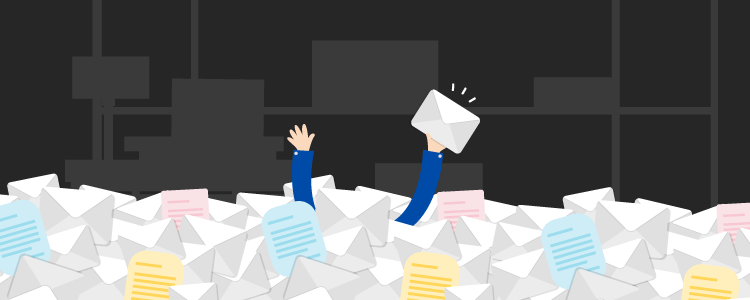
Email is one of the most popular channels for online marketing and offers a host of benefits for bloggers.
In fact, a survey by The Manifest found that 69% of businesses spend time and money on email marketing.
It can help to get more eyes on your articles and is a great way to generate sales. In fact, a survey by Litmus found that for every dollar a brand invests in email marketing they receive 42 dollars in return.
There are many types of emails that you can send to your list. Each with different functions. In this article we will explore some of the most popular types, explaining how they can help you and how to construct them.
1. Welcome email
What is it?
A welcome message to introduce people to your email list, product or course.
Why do you need it?
They say “you never get a second chance to make a first impression” for a reason. Welcome emails are one of the first opportunities for readers to get to know you and your brand, and set expectations for the future.
A survey by GetResponse found that they have a VERY high open at over 82% and a click-through rate of approximately 27%! This is one email that you don’t want to miss out on.
They can help to share your story with readers and build trust. Increasing your readership and setting up lead nurturing for future emails.
How to create an effective welcome email
- Write an eye-catching subject line: Subject lines are crucial to the success of your email. They are one of the few elements that a reader uses to decide if they will open an email. Welcome email subject lines are no exception. You could keep it simple with a plain “Welcome to my mailing list” etc. or you could get a little more inventive.
- Introduce yourself: Explain a little about yourself and your story. Sharing some personal information can start to build a connection with your readers.
- Say “thank you”: Let the reader know that you appreciate them being there. Aweber believes “thank you’ is one of the most effective words you can use in an email, as it adds a human quality and increases brand loyalty.
- Tell them what to expect from you: Will you be sending a series of emails. Will you be giving them updates on new content? A monthly newsletter? A series of emails?
- This helps to set expectations from your list. It can encourage people to stick around and it can also lower the risk of unsubscribes later down the line if you are sending too many messages.
- Ask them to whitelist you: This can get a bit confusing, as it can be a different process for every mailing provider. But, in essence, you are asking readers to mark your content as important to them. This increases the chances of your emails being delivered instead of going straight to spam.
- Ask to connect on social channels: This is a great opportunity to ask readers to follow you on your social channels, as they are likely to be engaged with what you have to say.
One of the welcome emails Blogging Wizard sends to new subscribers ticks a lot of these boxes:
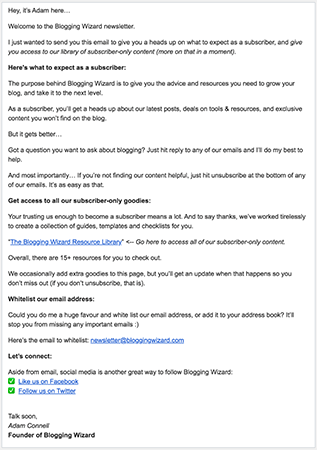
2. Newsletter
What is it?
A regular email updating your subscribers of anything new about your brand or blog.
It could include:
- New content
- Old content (that you want to increase views on)
- Announcing a new blogging series or theme
- New offers on products
- What has been going on in your personal life
- Added value for the reader – tips, how-to’s, etc.
Why do you need it?
Newsletters aren’t just a chance to tell your readers you’ve got a new kitchen or that you’ve started a new series on Netflix. They can be a powerful marketing tool.
Their benefits can include:
- Increasing views on new content
- Increasing sales
- Letting readers know about offers
- Increasing traffic to landing pages
- Increasing awareness of a new product or service
- Increasing social media followers
How to create an effective newsletter
- Segment: Segmenting your list is one of the golden rules of email marketing. It can help to make all the emails you send more effective, including newsletters. Sending out variations tailored to different segments of your list can help to increase your open and click-through rate. Hello more pageviews and conversions!
- Add value: Giving value to your readers helps to increase trust in your brand. This can lead to more readers and, ultimately, sales. You could offer tips or guides within your email and link out to other pieces of content.
- Personality: Let your personality shine through a little in your newsletter. You could share something that is happening in your life right now if you feel comfortable or use some humor. Again, this can help to build a connection and trust with your readers.
- Something old and something new: Your newsletter doesn’t have to just promote new pieces of content, take this opportunity to increase views on older articles that are still relevant.
- Pay attention to the layout: Sometimes there can be a lot to say in newsletters, be careful that your page isn’t crowded with long blocks of texts and lots of call-to-actions.
- Ask for feedback: Asking your readers what they would like to see in your newsletters can be a great way of doing customer research. This can help you produce even better emails in the future and inform all of your marketing strategies. It also encourages communication between you, which gives another opportunity to build a connection.
Here’s another example from Blogging Wizard:
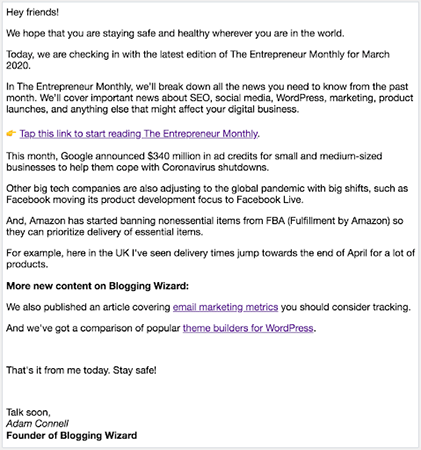
3. Re-engagement email
What is it?
An email reaching out to inactive subscribers on your mailing list, to get them to engage with your messages again.
Why do you need it?
When you have people on your email list that are not engaging with your emails, this can damage your deliverability. This increases the chances of your well-crafted emails landing in the spam folder.
It can also be much cheaper and easier to re-engage existing subscribers than to acquire new ones.
How to create an effective re-engagement email
- Find out why people aren’t engaging: Knowing why people are not engaging can help you craft your emails accordingly.
Active campaign compiled a handy list of some of the reasons people stop engaging:
- Too many emails
- Clickbait subject lines
- Confusing design
- Not optimized for mobile
- Repetitive or irrelevant content
- Only signed up for a one-time offer
- Asking subscribers to complete a poll or survey with a free gift incentive
- Online competitions
- Product recommendations
- Make it part of a campaign: It is unlikely that one email will be enough to rejuvenate someone’s interest in your brand. Instead, craft a campaign aimed at different segments of subscribers.
- Attention grabbing subject line: It’s extra important here that your subject line catches the reader’s eye. If they are unengaged anyway, then they are more likely to pass over your email without opening.
- Give them a reason to return: Offer an incentive to get them to return, such as access to exclusive content or a discount off one of your products or services.
- Personalize: Personalized emails can help to increase connection and stimulate engagement. Tailor your email to each recipient. Things such as their first name, links to content that match their interests and relevant tips in the email can help here.
Check out this re-engagement email from video creation service, Animoto:
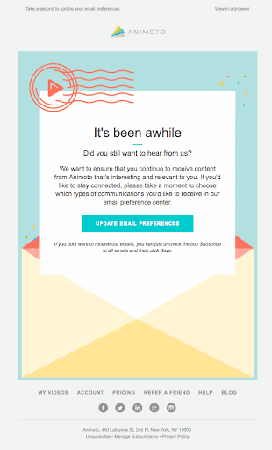
4. Abandoned shopping cart email
What is it?
An email sent out to visitors that leave a full shopping basket on your site. The aim is to get them to come back and make a purchase.
Why do you need it?
This is an important email if you sell products on your blog.
A lot of money is lost yearly to abandoned shopping carts. In fact, in a study by Barilliance the abandoned cart rate for the United States in 2019 was approximately 72%.
Email can be very effective for recovering some of this lost revenue. In a study by Moosend over 40% of cart abandonment emails were opened, 21% of these received click-throughs and 50% of people that clicked through made purchases!
How to create an effective abandoned shopping cart email
- Include it in a series: Sending out a series of abandoned cart emails can be more effective than a stand-alone message.
- Personalize: You can personalize your abandoned cart emails with details such as the recipient’s name, details or an image of what was in their cart.
- Segmentation: Use segmentation to further personalize your emails. Neil Patel recommends segmenting into categories such as first time abandoners and existing customers to help create more relevant messages.
- Timing is important: When you send your emails can impact how successful they are. The exact timings that work for you can be specific to your business.
- Use social proof: This can be a powerful way of increasing conversions, a review or testimonial about your product may help to convince readers to finish what they started.
Below is a simple, yet effect abandoned cart email from FiftyThree:

5. Lead nurturing emails
What is it?
A series of emails that develop awareness and trust in your brand, with the end goal of making a sale.
Why do you need it?
If your blog sells products or services, lead nurturing can be an effective way of increasing the number of sales, and the average order value of each sale.
Lead nurturing can help to turn readers into customers by building trust in your brand over time.
How to create an effective lead nurturing campaign
- Don’t sell straight away: It’s important to remember not to be too sales focused at the start of your campaign. You want to build a relationship with readers first. It’s similar to building a relationship in real life. You wouldn’t suggest moving in with someone on the first date, would you?
- Get personal: If you are comfortable, sharing some personal details about yourself can help to foster a connection and help with lead nurturing. Is there a particular part of your story that shows you had similar struggles to your customers? Did you overcome them?
- Understand your customers: It’s important to understand your customers to create emails that resonate with them. What is their world like? What needs do they have? How can you help them?
Doing target audience research and creating buyer personas can help you create emails that add value for the reader. And they will also demonstrate that you understand their pain points. All of this helps to build…you guessed it….trust.
- Decide on timing: The timing of each email is important. Too many emails, too often, could frustrate people, but leave it too long and they may forget who you are. The exact time-line that works for you can be individual to your business.
- Vary your content: Try out different types of content to keep your campaign interesting and see what works for you. You could include videos, infographics, podcasts and more. It doesn’t all have to be the written word. And consider experimenting with content length.
Lead nurturing emails can take many forms.
You could go for a straightforward email packed with value and advice that’s relevant to your subscribers.
Or you could opt for a more ‘hands on’ approach that allows you to learn more about your subscribers and help them in a more meaningful way. These emails are usually shorter and focused on a single question.
Here’s an example from Blogging Wizard:
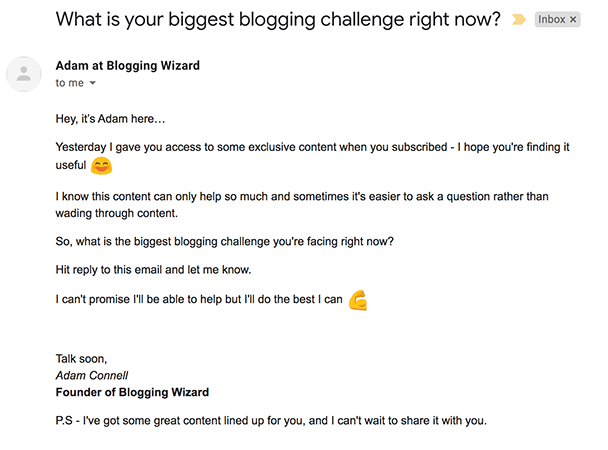
This type of email is difficult to scale but results in meaningful interactions with subscribers.
Bonus: Email marketing best practices
Best practices
There are some best practices for writing all emails we have not covered here, such as how to create strong call-to-action buttons and how to format your emails. Check out this article for more detail on some of these things.
A/B testing
If you want to optimize your emails for maximum conversion, it’s important to A/B test elements of each email to find what works for your brand personally.
What works for one brand may not work for yours, and what works today may not work next week.
A/B testing is simply changing one element of an email at a time and seeing which has the most positive outcome. A quality email marketing service provider will have the tools to do this easily.
The takeaway
We hope this article has offered you some insight into popular email types and how they can help your blog.
It’s important to make sure that your emails are relevant to your audience, no matter what type they are. Make them as engaging as possible and A/B test to keep them optimized.
Email can increase your readership and the revenue you make. So, fire up your mailing platform and start crafting some enticing messages.
Related Reading: The Best Time To Send Emails (Meta-Analysis).

